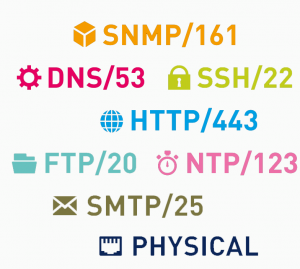Port Monitoring
Comprehensive port monitoring software

- PRTG monitors for open and closed ports.
- PRTG monitors throughput.
- PRTG monitors traffic.
- PRTG monitors connections using the UDP and TCP protocols.
- PRTG uses SNMP, NetFlow, and packet analysis.
What is port monitoring?
Monitoring ports on your network can improve bandwidth usage and increase security. Because all data packets sent over the network are sent and received through a particular port, port tracking allows you to estimate the actual data traffic and bandwidth usage on your network.
A good port tracking tool includes bandwidth monitoring technologies such as SNMP, Flows (NetFlow, IPFIX, sFlow, jFlow), packet analysis, and/or WMI, and provides detailed statistics for bandwidth planning. It also allows you to monitor port health to identify potential security risks caused (accidentally) by open ports.
Port Protocols: Definition, Traffic, Security
DEFINITION
A port is the part of a network address that ensures that connections and data packets are properly distributed. Valid port numbers range from 0 to 65535. Many applications use typical or standardized ports (“known ports”) that are typically registered with IANA. These include FTP (port 20), SMTP (port 25), and SNMP (port 161). These ports are primarily used by protocols such as Transmission Control Protocol (TCP) and User Datagram Protocol (UDP).
TRAFFIC MONITORING
Many administrators look for port monitoring software to monitor the traffic that is sent between routers and switches and the amount of bandwidth consumed. In fact, they need software to monitor network performance. The advantage of PRTG is that it is a comprehensive monitoring software. It uses port analysis in conjunction with SNMP as a bandwidth monitoring tool.
SECURITY
Open ports put your network at risk. For example, they are used to introduce Trojans. While many administrators are indeed seriously focused on security, constantly inspecting open and closed ports requires superhuman efforts. Often, ports are temporarily opened for individual applications and then forgotten. In such cases, PRTG uses the TCP protocol and provides administrators with up-to-date information through a built-in configurable alarm system.
Time to make a decision: separate port monitoring software or a comprehensive solution?
Individual applications. When searching for port monitoring software, you’re bound to stumble upon a number of separate applications, such as CurrPorts or Port Scan. In the short term, such decisions may not be so bad. However, they usually make monitoring difficult and confusing. Those who choose multiple separate applications have to put up with increased maintenance costs and often limited functionality. Thus, it is extremely difficult to constantly monitor the operation of the network.
Advantages of PRTG. By purchasing PRTG, you get a single centralized tool for monitoring the operation of the entire network. The test version is provided free of charge and includes all the sensors and functions of the program. This way, you can get an impression of our software for free and without any risks and even set up port monitoring and collect some initial data. Purchase the premium version at any time.
Port Monitoring: Five Reasons Why PRTG is the Right Choice for You
COMPREHENSIVE TOOL
SNMP, packet analysis, or NetFlow: the program has all the standard monitoring protocols. The notification system is also included in the general package. Get started with a centralized monitoring tool that works across your entire network and focus on other tasks. Many administrators use PRTG because they want to get rid of the “hodgepodge” of monitoring tools.
EXPERIENCE
For almost 20 years, Paessler AG has been exclusively developing its PRTG monitoring software to offer you the perfect network monitoring tool. Today, more than 200,000 administrators around the world entrust the monitoring of their networks and traffic to our software.
SUPPORT
The PRTG program is accompanied by extensive support. We aim to resolve every support request within 24 hours (on business days). Our knowledge base contains a number of specific tips for working with the application. There you will find answers to many of your questions. Our user manual also contains instructions for each sensor.
REPORTS
PRTG allows you to create your own custom reports. From these reports, you can explore bandwidth trends, system load, and many other parameters over months or years. This will help you in your long-term network infrastructure planning. You can also identify download spikes and respond quickly to them.
ALARM
PRTG comes with a built-in notification system. Such alarms are fully customizable. You will only receive a notification if an error occurs. At the same time, the alarm can be set up to alert you in advance, before major problems or system failures occur.
What ports does PRTG use?
PRTG requires certain ports to function properly. The administrator will need to release them.
Web server. The Web server requires TCP ports 80 (HTTP) and 443 (HTTPS), and uses spare ports 8443, 32000+ (HTTPS), and 8080 (HTTP).
Reports. Reports are sent as PDF files. This requires port 8085.
Automatic updates and activation. Automatic updates and activation require port 443.
Check and download updates. Port 80 is required to check for and download updates.
Integration with Active Directory. Ports 389 (TCP and UDP) and TCP 636 (SSL secured) are used here.
Remote probes. Port 23560 is required to establish connections between the remote probes and the underlying server.
Cluster. Communication between the nodes of the cluster is carried out through port 23570.
PRTG cloud. TCP port 443 is used to access the PRTG cloud (for example, for push notifications, cloud echo request sensor, and cloud HTTP sensor).
SNMP. For SNMP, UDP port 161 is used.